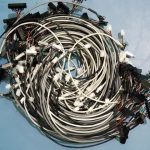Cabling & Harnesses
As part of the cables production, there are cables that come ready from the cable provider and then the work carried out in our factory includes only the wiring of the connectors. This type of working process usually refers to cables which are manufactured for civilian and/or medical industries; while the electronics and electrical wiring manufacturing require a more complex work of performing the wiring. The working process is even more complicated when it comes to military cables and harnesses. This process required to carry out the job on top of a board on which is drawn a mechanical draw at real-size measurements in accordance to the requirements.
In the cables we use various types of wires, in different colors and thickness (according to drawing requirements and customer demand), which we weave together and unite using knot string or shrink sleeve. This is the way, we basically create an entire cable consisted of several conductors, some of which may be wires or cables, and others may be shielded and/or coaxial. The cable itself can include general shielding of all the conductors beneath the outside covering, next step is connecting connectors in the edges, while the wiring is performed according to an electrical drawing received from the customer.
Our specialties:
- Complex cables
- Power cables
- Concatenation cables (Igus)
- Split cables (harnesses)
- Flat cables
- Integration Cat5e
- Cables of Cat6 Patch
- Coax Integrated cables
- RF integrated cables
- Servo & Linear motors wiring per customer requirements
- Manufacturing of cables sets in small series (supply up to 48 hours).
- Manufacturing of medical cables (Including the characterization of new raw materials in Europe and in the Far East).
Wiring Check
In order to check the wiring, technicians perform a wiring check that assists them to find
and isolate the problem.
There are several types of wiring checks:
Continuity Check – in the Continuity Check the wiring integrity is tested. We check if there is a part where the wire is disconnected and thus creates an electrical short-circuit. In order to test a short-circuit it is necessary to connect a Multi meter between the two ends of the wire (usually between two factions).
Short Circuit Check- the assumption is that one circuit should not be connected to any other circuit, that’s why short-circuit checks to other wires and systems are being carried out. If there is a short-circuit between two unrelated circuits it causes wiring damage and short-circuit that causes a signal from one circuit to pass to a signal of another circuit or system.
Ground Short-Circuit Check – if there is damage to wiring that causes ground short-circuit, the electric current flow increases dramatically and can compromise the aircraft’s integrity. Therefore, there is a test that checks the short-circuit between the wire to the fuselage that is used as grounding to all aircraft systems.
Ground Breach Check- if there is fear of ground short-circuit, but the short-circuit check didn’t indicate that there is a problem, there is another test which uses a Ohmmeter that pushes sudden high voltage and current in the wire and checks whether a short circuit has occurred. If a short circuit has occurred that mean that the isolation of the affected wire, in a certain place, doesn’t provide sufficient protection to prevent a ground short-circuit.













